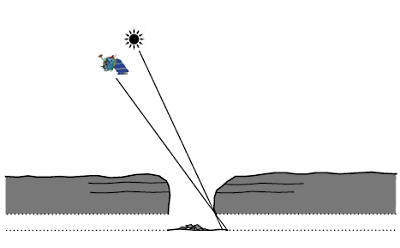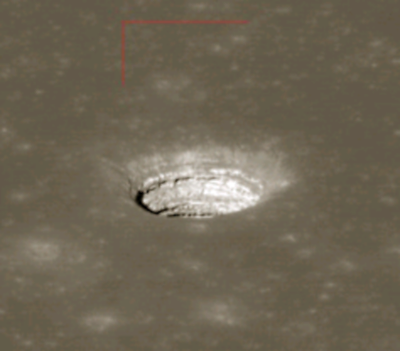The LROC Narrow Angle Camera acquired an oblique view of the Marius Hills "Haruyama Skylight" pit at just the right angle to reveal an overhang. The pit is about 65 meters in diameter (LROC NAC observation M137929856R, LRO orbit 5460, August 31, 2010) [NASA/GSFC/Arizona State University].
Marc Robinson
Principal Investigator
Lunar Reconnaissance Orbiter Camera
Arizona State University
Since LRO completes a full cycle of lunar imaging each month, it is possible to follow up previous discoveries and re-image targets under different lighting conditions. The LROC team waited patiently until the Sun and orbit position in the Marius Hills region was such that the bottom of the previously imaged pit wall was illuminated at just the right angle so that if there was an open lava tube extending horizontally its floor would be illuminated. The spacecraft slewed 43° to the east and the solar incidence angle was 34° from vertical.
Schematic of the imaging geometry in cross section, allowing a view of the lava tube floor [Arizona State University].
In this geometry, the NAC was able to image a few meters under the overhang discovering a sublunarean void! Will astronauts someday explore under the mare? What scientific riches wait to be discovered within the unseen reaches of sublunarean voids?
LPSC XLII (2011) #2771, Figure 2b. "The Mare Tranquilitatis pit, imaged at LRO nadir (0.00°) (2a) and -51° (2b) slew angles; images; M126710873R and M144395745L, respectively. Note layering complexity, differentially modified pit wall profile, and funnel-shaped rim in 2b (red scale bars are ~ 100 meters along each length" [NASA/GSFC/Arizona State University].
Also note how the oblique angle really brings out the layered nature of the mare bedrock in the pit walls. These exposed layers give scientists important clues as to how the vast mare were deposited.
Explore the entire oblique image! Read the 2011 Lunar and Planetary Science Conference abstract describing details of this fascinating discovery.
Also check out previous Featured Images of the Mare Tranquillitatis and Mare Ingenii pits.
Explore the entire oblique image! Read the 2011 Lunar and Planetary Science Conference abstract describing details of this fascinating discovery.
Also check out previous Featured Images of the Mare Tranquillitatis and Mare Ingenii pits.





4 comments:
Very cool. The schematic shows just what shape of habitat balloon will be needed.
Does anyone know how air tight lava tubes are? Perhaps after rover profiling of the inside, one may fabricate bulkheads to exactly fit the walls and hold an atmosphere that way.
Nothing is easy or cheap on the moon but if we can inflate stadia domes on earth, we can inflate hermiticaly tight, translucent domes over this hole. It would provide an instant greenhouse big enough to feed a small town.
Too bad Marius Hills are so far from the polar water and perpetual light.
Homefire
Extensive studies have been completed on lava tube habitation, though I can't remember specifics on how air tight they might be - I do remember the topic coming up. What I can remember off-the-cuff is the advantage >30 meters of regolith provides as protection against solar and HE cosmic radiation, and the vast majority of meteor bombardment.
What surprised me is how rounded and large the Tranquility Pit has been discovered to be, like a bullet hole.
As far as the volatiles are concerned, the "random walk" scenario, and the patina of hydroxyl and water molecules that form closer to equator coincident to hydrogen streaming with the solar wind, might make these lower latitude "permanently shadowed" interiors reservoirs of volatiles.
Some of the Kaguya investigators are now certain the three similar "crater pits," or "skylights" are all we are likely to ever discover, but what if we ultimately discover a skylight pit in or near the permanently shadowed regions? Not all the other experiments flying on LRO have the same resolution, after all. A lot of further surveyor work is going to be needed, of areas above and below the surface.
Thanks Joel,
For the short term maybe one should drop a Bigelow Sundancer down the hole.
I can't wait to see a rover go ice skating below.
Googling around i found this:
Junichi HARUYAMA had this to say:
The in-situ exploration in the Apollo program showed that the temperature a few meters under the surface around the landing area is constant at about -20 deg. C. On the other hand, final-flow lava coagulates at the bottom of the lava tubes making it flat frequently. In other words, the bottom is just like a naturally paved surface. In addition, when tubes were formed, their inner walls were often rapidly cooled, which made them very airtight. By sealing the front and back tube exits, it is easy to create a pressurized space. Furthermore, inside lava tubes, there is no need to care about the finely crushed-ash-like sand covering the lunar surface, which severely hampers activities on the lunar surface.
http://www.isas.jaxa.jp/e/forefront/2010/haruyama/03.shtml
From Nasa Lunar Science Institute:
Penetrative cracks in the roof may exist, which would make it extremely difficult to render the enclosed volume airtight, but the lava tube could act as a receptacle for self-enclosed habitats.
http://lunarscience.nasa.gov/articles/lava-tube-lunar-base
We're going to need to know the "ground truth" eventually, one way or another. I've also seen studies of methods to roof rilles, many of whom are likely "collapsed" lava channels, including Hadley Rille south of the Apollo 15 site.
For three years we've been studying the relationship between the Reiner Gamma swirl albedo and the Marius Domes shield volcano in western Oceanus Procellarum. That the two phenomena are linked is evidenced by the surface markings themselves, which may turn out to be sealed off lava tubes, perhaps a system 100's of kilometers long. The intense magnetic field accompanying the markings may indicate a higher than normal ferrous context flash hardened on the walls, as well as the floor.
The value of some protection afforded to personnel and equipment from lunar dust, even within a native field that seems clearly to be affecting the "normal" pattern of micro-grain migration, dispersal and precipitation, can't be underestimated.
Thanks for the links. We have so much research data to sift through it's daunting. And the tubes, caverns, etc. on the Moon (and admittedly Mars and Mercury, for that matter) do inspire a lot of interest.
Post a Comment